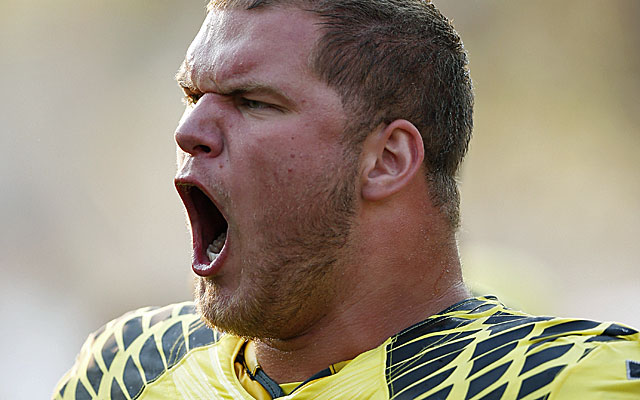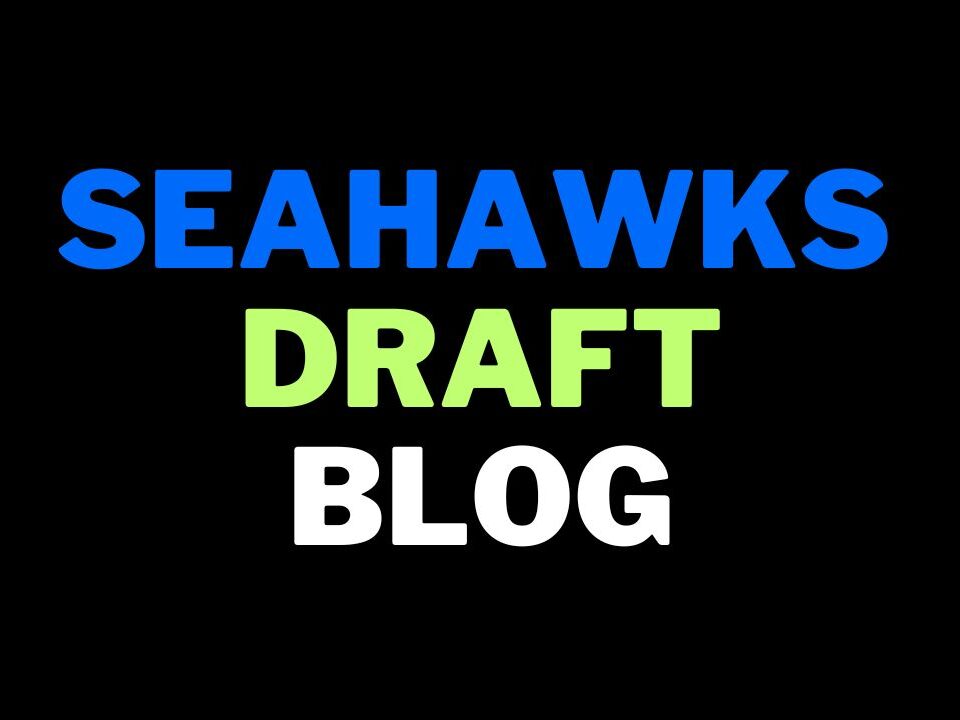
Jake Fisher stole the show at the combine today
If you missed today’s combine live blog, you can recap the day here. It includes workout notes, winners & losers, measurements, breaking news and a lot more
There were several key performers today but nobody had a better athletic performance than Oregon’s Jake Fisher. His 7.25 in the 3-cone and 4.33 in the short shuttle were top-five for OT’s over the last decade. He ran an official 5.01 in the forty yard dash with a 1.75 ten yard split and posted a 32.5 in the vertical jump.
Nobody came close to that kind of performance this year. It brought back memories of Joel Bitonio twelve months ago and Kyle Long in 2013. Both players went in the top-40 of their subsequent drafts. Fisher might be on the fast track to a similar result this April.
I’ve spent the last hour digging through some Oregon TV tape to have another look at him. Here’s some thoughts before we get into his potential fit in Seattle…
He doesn’t jump off the screen like Bitonio, but then it’s easy to forget just how accomplished Bitonio looked at Nevada. Against top-tier opponents in 2013, he excelled (National Champions Florida State, Anthony Barr and co at UCLA). He mirrored well in pass protection, drove people off the ball in the running game, loved to get to the second level and played with a constant edge. I recall one play against Fresno State where he dumped a linebacker on his backside. He finished plays every game.
I guess you’d call Fisher more ‘finesse’, but that’s really just a kind way of saying he doesn’t play with the same level of intensity. He’ll do his job on each given play to a reasonable level. But he rarely goes above and beyond — rushing to the second level, finishing a block with a little extra spice or driving someone out of a play after the whistle. He’s very grabby and gets a ton of flags (six for holding in 2014 alone). You don’t see the same kind of raw attitude. He’s a converted tight end and plays up to that.
One thing he does really well is recover. In the National Championship against Ohio State there were at least two occasions where he got beat on an inside move in the run game. He had a nice counter — pushing the defensive end into the pile and creating a new crease off the edge. In one particular play it created a huge lane for the running back. You can’t expect him to dominate every snap so it’s good that he’s alert and intelligent enough to counter-attack.
He’s an effortless lateral mover — that’s no surprise given what he achieved at the combine today. He’ll be able to cope with speed. There’s very little tightness in his hips and that’ll bode well if a team decides to keep him at tackle (more on that later).
Sadly, though, he is not a great run blocker. Not yet, anyway. He lacks punch and very rarely pushes people off the LOS. He can hold position nicely, but you don’t see those ‘wow’ blocks where the defensive lineman just gets jolted back. His footwork, while good when he tries to set in pass protection, is inconsistent in the running game. He needs to keep moving and work the defender, using his speed and size as an advantage. Too often when he initiates contact he stops and tries to win purely with upper-body power and this is where he struggles. He should get better here over time, but for now it is what it is. He must continue to get stronger.
Both Bitonio and Long showed more snap on tape. For that reason it might be worth pumping the breaks on his sky-rocketing stock. Yet the fact is — there just isn’t anyone with his level of athletic upside available at offensive tackle this year. There’s no Greg Robinson or Taylor Lewan. No Bitonio sitting there in round two. We’ve talked about this a lot — the top college athletes are gravitating towards defense. It’s been happening for a while. And it’s putting a premium on athletic offensive linemen who can match-up at the next level. It’s why Eric Fisher jumped Luke Joeckel as the first pick in 2013 — and it’s why Lane Johnson went in the top five.
There’s a big market for players like Jake Fisher in the league, however much work they require. A top-40 grade feels right today, but you’d still expect several other offensive linemen to leave the board first (including Andrus Peat, T.J. Clemmings, La’el Collins, Brandon Scherff and the blossoming D.J. Humphries).
So what about his fit in Seattle?
Some people believe a long-term plan is required on the offensive line, essentially to prepare for life after Russell Okung. I’m not one of those people. For me, Okung is a core guy on the offense. I don’t think he’s in the top echelon of NFL left tackles, but he’s probably in the next tier. It’s incredibly difficult to find even a solid starting left tackle and they usually cost a top-ten pick. The Seahawks have their guy and depending on what they do in free agency, they should work to extend his contract which expires after the 2015 season.
Of course, this all depends on what happens in free agency. If the Seahawks make an improbable move for Ndamukong Suh, they’re going to have to make savings somewhere. Signing Suh is attractive but still only a dream at this point. I’d expect Seattle to be active in free agency — probably to add a veteran receiver or tight end and maybe some depth to the defensive line — without spending mega-money.
There’s a theory that Okung is too banged up — and he has missed games. A bit of context is required though. Okung has never missed a full season or even most of a season. His most injury hit campaign was 2013 when he played eight regular season games. It’s easy to forget how poorly the O-line played in his absence with Paul McQuistan and Michael Bowie at tackle. He returned late in the season to help the Seahawks win their first Super Bowl. He was needed.
In 2014 he missed two games. In 2012 he missed one game. Bobby Wagner has missed seven games in the last two seasons. Players are going to get injured. Had Richard Sherman, Kam Chancellor and Earl Thomas picked up their late-season injuries earlier, they probably go on I.R. in 2014. Okung has a tendency to get banged up, but it’s more a case of frustrating niggling injuries instead of anything career threatening. This is part of the game and for me, it’s overstated when people talk about Okung. Especially when you consider every member of Seattle’s starting offensive line has missed time in the last two seasons.
The idea you could draft a tackle at #31 and use that player to replace Okung down the line is slightly fanciful for me looking at this crop of players. None get close to the kind of quality Okung showed entering the league. You’d be banking on serious development at the next level. I’d rather look into a Jared Veldheer type extension for Okung like Davis Hsu has suggested — he penned a 5-year, $35m deal with the Cardinals.
Of course it’s not just about potentially replacing Okung. James Carpenter is a free agent and might not be retained, creating a hole at left guard. I’m not convinced Alvin Bailey will simply step in to replace Carpenter. Even if he does, they need to add depth to the offensive line.
You could draft Fisher and move him to left guard. The switch to guard worked well for Kyle Long. You could put Fisher at right tackle and move Justin Britt inside. Would either move appeal?
Firstly, Fisher is a very different player to both Carpenter and Bailey. I’m not sure if Seattle is totally focused on massive size and length at left guard, but that’s what the current incumbents provide. Carpenter is 6-5 and 321lbs. Bailey is 6-3 and listed at 320lbs (but looks bigger). I quite like the size they bring even if performances have been inconsistent. Long is 6-6 and had to work to get to 306lbs for the combine. Run blocking, as discussed above, is not his calling card. The Seahawks do run a zone blocking scheme at heart, but they’ve also used players like Okung, Carpenter, Bailey and Giacomini to offer some power/size and grit. I suspect they’d like to retain that edge. With Fisher, Sweezy and Britt all starting on the line — there’s a real danger they’d get over-matched against tougher opponents (eg Arizona).
The Seahawks want to run the ball as their identity — I’m not sure getting lighter at guard will aid that cause.
Would you move Britt inside? Possibly. He had a mixed first year at tackle and has similar size to Carpenter (6-6, 325lbs). He also has short arms and might even suit the switch. The Seahawks like their guards to have tackle experience. It makes some sense. It would also mean two high picks at right tackle (Carpenter, Britt) who lasted a year before needing to move inside. If Fisher is also better suited to guard, are you going for the hat-trick? How many high picks do you want to spend trying to solve a position (RT) that most teams fill without the big price tag?
I wonder whether Fisher’s best role at the next level might be at right guard — just like Kyle Long and Seattle’s own J.R. Sweezy. He’s smart enough to play the position and teams seem to like extra mobility in that area. Of course, the Seahawks already have a long term starter there (and J.R. Sweezy is almost assured of a contract extension considering how much Pete Carroll gushes about his performances).
Ultimately I think it comes down to this — how much of an upgrade are you getting swapping Carpenter for Fisher (if any), versus swapping him for someone like Terry Poole who also enjoyed a good combine workout? Tony Pauline reported at the Senior Bowl that Seattle has interest in Poole. He also has tackle experience. He has similar size to Fisher (shade under 6-5, 307lbs, 33 1/4 inch arms) and also tested well (1.79 split, 5.09 forty, 31 inch vertical, 7.90 3 cone and 4.66 short shuttle). Poole could be had in the mid-to-late rounds but if you want Fisher, it might be #31 or bust.
There could be other options in the late first round based on today’s workouts. Ereck Flowers performed poorly in drills but he’s a terrific drive blocker who plays with an edge. On tape you really see him finish blocks — in one game he drove a right end to the left sideline and played beyond the whistle. He gets a nice push at the LOS in the run game. He has experience playing both tackle spots, he has size (6-6, 324lbs) and enough foot speed to evolve into a ZBS tackle or guard.
Today’s sluggish display could cost Flowers a place in the top-25, but is he be an alternative choice to someone like Fisher? He has 34 and a half inch arms. His official 5.31 forty time isn’t great, but it’s better than Ju’Wuan James’ last year (5.34) and he looked the part of an established NFL tackle in 2014.
Cameron Erving is also an intriguing option. He’s versatile enough to play guard, center or right tackle. The NFL Network pundits repeatedly compared his physical skill set to Eric Wood — which is no bad thing. He ran well — posting a 5.15 at 6-5 and 313lbs. He has 34 and 1/8 inch arms. He’s a work in progress as a converted defensive lineman who only kicked inside last season after starting at left tackle. He’ll be a tremendous project for the offensive line coach who gets to work with him at the next level.
And then there’s La’el Collins, who had a really good day today. He looked good in the Senior Bowl game, if not during the daily workouts. I’ve flip-flopped on Collins, originally seeing him as a top-five prospect in this class, then feeling he would be better at guard and more of a top-15 selection as a consequence. The all-22 tape against Alabama exposed some flaws (lack of push off the line, tendency to lunge) and suggested he simply had to move inside. But then you see this workout and can’t help but be impressed. He looked superb carrying very little bad weight. He moved around in the drills with a lot of grace for his size. He ran a nice 5.12 at 6-4 and 305lbs. I think he’ll go in the top-25.
Don’t sleep on Rob Crisp by the way — a player we highlighted during the college season. Nobody dealt with Vic Beasley better than NC State’s Crisp last year. He’s 6-6 and 5/8th’s, 301lbs, has 34 and a half inch arms and had an impressive 32.5 inch vertical jump plus a good 4.60 in the short shuttle.
Players like Crisp and Poole offer some depth to this class, not to mention other performers today like Mitch Morse, Ali Marpet, Takoby Cofield, Jamil Douglas, Donovan Smith and Jeremiah Poutasi. There is real depth on the OL to go with the options at WR, RB and DL. Seattle can afford to let Tom Cable keep adding his guys, even if Fisher’s performance today warrants greater attention moving forward. On the other hand, the #31 pick has the potential to be a bit of a sweet spot for offensive linemen.







